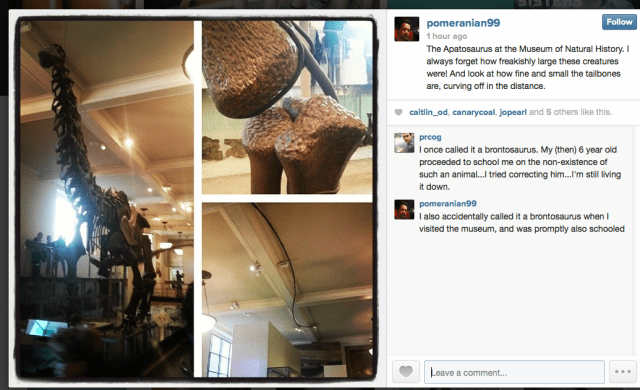 This is the fourth and final of my four part interview with Clive Thompson, as we sat between our T-Rex and Apatosaurus. This segment focuses on designing museums in the digital age.
This is the fourth and final of my four part interview with Clive Thompson, as we sat between our T-Rex and Apatosaurus. This segment focuses on designing museums in the digital age.
Clive, we’re sitting here talking about all these ways that digital media can augment our abilities to think, to access our minds, to connect with others, think with others and have deeper understanding and reflection after the event. We’re doing this in a museum that was founded in 1869, looking at dinosaurs that are millions of years old, where the tools that we are talking about that can empower that kind of thinking are like “a blip of a blip” in the timeline.
So if this museum was created today, if you were re-designing this hall, and you were thinking about what it would mean for a Natural History Museum to create a space that could support people to use these tools, what would you do?
That’s a really good question. I’ll start off by saying I have an enormous respect and fondness for people that create museum exhibits. They’re the first people to have had to think through the implications of multimedia. When they are communicating this to the public, trying to explain dinosaurs, they use text. There’s pictures. They had to decide what physical items should we have. And then there are these sound guys, the first people to start asking, “Why don’t we have the ability to walk through here and have someone talk on computers?” So in this room there’s four forms of media, being used right now, pioneered by museum people. People in the news media didn’t have to think this way. Teachers didn’t have to think this way. But museum exhibit people have been working in multimedia for like a 150 fifty years, frankly, so this room is already a lot richer than most other places you’d see.
If you wanted to add more to it, there are a couple of low hanging fruits. The dinosaurs are wonderful physical artifacts and it’s often startling to realize how big they are, or what their shape is. Look up there at how serrated that tooth is on that T-Rex. How big is that? Well, what would it be like if I held it in my hand? In fact one thing you can start to do is to make these physical objects shout using 3D printing. These days you have a lot of 3D printers that are becoming cheaper. This is essentially the transmission of physical piece of knowledge across the ether. What if I could go to an online site and download and print a copy of any parts of this dinosaur, because I would love one of those teeth, you know? Imagine: having just one of those just sitting on my desk would be a really cool way to reflect on the size and might of this enormous creature. So the physical sharing of these rich artifacts I think is a fantastic new form of media that’s coming along.
The second thing is you can actually do some really cool things with augmented reality. Augmented reality is the concept of being able to hold up the phone and having it overlay over what you’re seeing – information that helps you look at in a different way or learn things about it. And by and large a lot of our augmented reality has not worked very well in the everyday world, but I think it’s because in the everyday world, we often don’t really want a huge information rich experience as we walk down the street. But I could have a little app that I can load and pull it back and forth and be able to see different parts of that dinosaur, with labels, as I move it back and forth, or see the way that the jaw moved. These are ways that would really help me get new dimensions out of what’s physically in front of me. So there is a couple of things that I think we could start to do.
You could probably think a little bit about integrating public thinking into an environment like this. [re: part two of this interview]
How can I, as a visitor to this hall, know what other people are thinking here?
Well, yeah, that’s a fun question: so how can we identify the most interesting things anyone has said about this dinosaur? You know, what are the three most up-voted smartest reflections. It could be someone’s having a thought, or a visitor who had some interesting visceral reaction to this, or it could be someone who has found an amazing quote in one of the newspapers in the 19th century when this thing was first uncorked. Those things are hard to engineer because the signal-to-noise ratio can be really high in public thinking. 90% of what people say online it pretty banal. And so we have that challenge, to find the best stuff people have said about this dinosaur, over and over again.
That’s a hard one to surmount, but pretty cool if you could do it.
Wow, I hadn’t seen that tail before. Holy Moses, that’s long!


